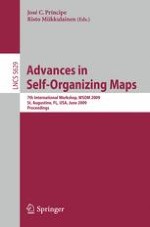th These proceedings contain refereed papers presented at the 7 WSOM held at the Casa Monica Hotel, St. Augustine, Florida, June 8–10, 2009. We designed the wo- shop to serve as a regular forum for researchers in academia and industry who are interested in the exciting field of self-organizing maps (SOM). The program includes excellent examples of the use of SOM in many areas of social sciences, economics, computational biology, engineering, time series analysis, data visualization and c- puter science as well a vibrant set of theoretical papers that keep pushing the envelope of the original SOM. Our deep appreciation is extended to Teuvo Kohonen and Ping Li for the plenary talks and Amaury Lendasse for the organization of the special sessions. Our sincere thanks go to the members of the Technical Committee and other reviewers for their excellent and timely reviews, and above all to the authors whose contributions made this workshop possible. Special thanks go to Julie Veal for her dedication and hard work in coordinating the many details necessary to put together the program and local arrangements. Jose C. Principe Risto Miikkulainen
